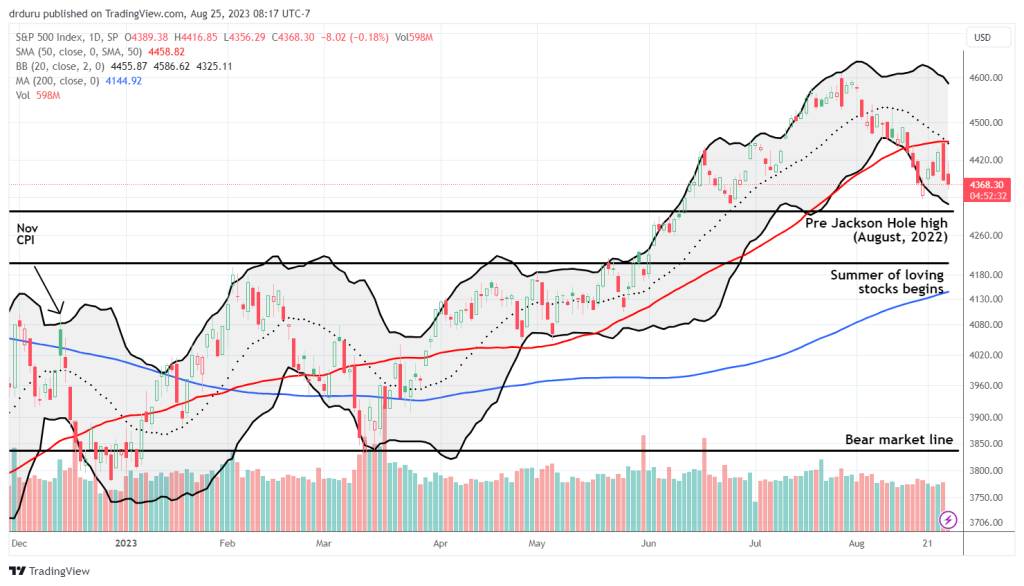What Powell Missed In His Jackson Hole Speech Explaining Inflation’s Drivers
Federal Reserve Chair Jerome Powell included a neat and tidy explanation of the drivers of inflation in today’s Jackson Hole Speech titled “Inflation: Progress and the Path Ahead.” However, Powell missed one of the key drivers that fanned the flames of all the other drivers: the Fed held interest rates too low for too long and left overall monetary policy extremely accommodative long after it was needed. In early June I laid out that case in detail combining the research of economists Gauti B. Eggertsson (Brown University) and Don Kohn (Hutchins Center on Fiscal & Monetary Policy, Brookings Institution) and my previous claims about the Fed’s role in creating high inflation. As a reminder here are the key points for the case of Fed-driven inflation:
- The Fed’s revised monetary policy framework in 2020 contained an inherent inflationary bias.
- The Fed relied too heavily on hawkish hints in the months leading into the lift-off for monetary policy.
- The Fed recognized too late that the labor market was sufficiently tight for higher rates.
Powell made no mention of any of these factors in his Jackson Hole speech. Instead, Powell provided a one sentence summary of the inflation narrative: “The ongoing episode of high inflation initially emerged from a collision between very strong demand and pandemic-constrained supply.” Even in describing the path to lower inflation, Powell avoided saying that the Fed needs to unwind overly accommodative monetary policy: “By the time the Federal Open Market Committee raised the policy rate in March 2022, it was clear that bringing down inflation would depend on both the unwinding of the unprecedented pandemic-related demand and supply distortions and on our tightening of monetary policy.” Inflation has to unwind itself along with the assistance of tightening policy.
Powell went on to provide a very familiar narrative about inflation:
- The Russian invasion of Ukraine has driven up headline inflation.
- “Demand for vehicles rose sharply, supported by low interest rates, fiscal transfers, curtailed spending on in-person services, and shifts in preference away from using public transportation and from living in cities. But because of a shortage of semiconductors, vehicle supply actually fell.” At least Powell acknowledged low interest rates helped drive excess demand for vehicles.
- “In the highly interest-sensitive housing sector, the effects of monetary policy became apparent soon after liftoff. Mortgage rates doubled over the course of 2022, causing housing starts and sales to fall and house price growth to plummet. Growth in market rents soon peaked and then steadily declined.” Here Powell chose to focus on the impact of higher rates on housing which of course implies that lower rates supported housing demand. He avoided noting how unnaturally low interest rates drove the housing market to mania levels of demand and pricing.
- “Part of the reason for the modest decline of nonhousing services inflation so far is that many of these services were less affected by global supply chain bottlenecks and are generally thought to be less interest sensitive than other sectors such as housing or durable goods. Production of these services is also relatively labor intensive, and the labor market remains tight.” Nonhousing services inflation presents the Fed with its most troublesome driver of inflation. Powell noted that inflation in this sector has “moved sideways” since monetary tightening began.
A stronger than expected economy is the upshot to the current inflation story. This above trend economic growth could force the Fed to continue hiking rates higher and for longer than current expectations. In fact, this economic strength is the exact opposite of what so many economists, pundits, and analysts have expected for 18 months or so. The most anticipated recession in U.S. history just refuses to materialize.
The current uncertainty leaves financial markets nervous. The U.S. dollar (DXY) is stronger than expected at this part of the cycle, the entire rate curve is moving higher, and the stock market looks wobbly. The NASDAQ (COMPQ) and the S&P 500 (SPY) have returned to their last highs preceding Jackson Hole 2022. What I have called the “summer of loving stocks” has already lost all its gains from July. August is just the first month of the three “most dangerous” months in the stock market. So even as the stock market approaches oversold trading conditions, obligatory rebounds may be insufficient to stave off a rollback of all the summer gains.
(Click on image to enlarge)
The S&P 500 (SPY) is confirming a failure at 50DMA resistance on its way to what looks like a more direct test of support from the high prior to Jackson Hole 20222.
(Click on image to enlarge)
The iShares 20+ Year Treasury Bond ETF (TLT) is challenging its lows from October and November. A further breakdown could trigger a fresh wave of selling in the stock market.
Be careful out there!
More By This Author:
Is The British Pound Topping Despite Lingering Strength In UK Core Inflation?
Base Effects Add To The Bank Of Canada’s Inflation Concerns
Why Monetary Policy Was Late In Responding To The Pandemic-Era Inflation Surge





